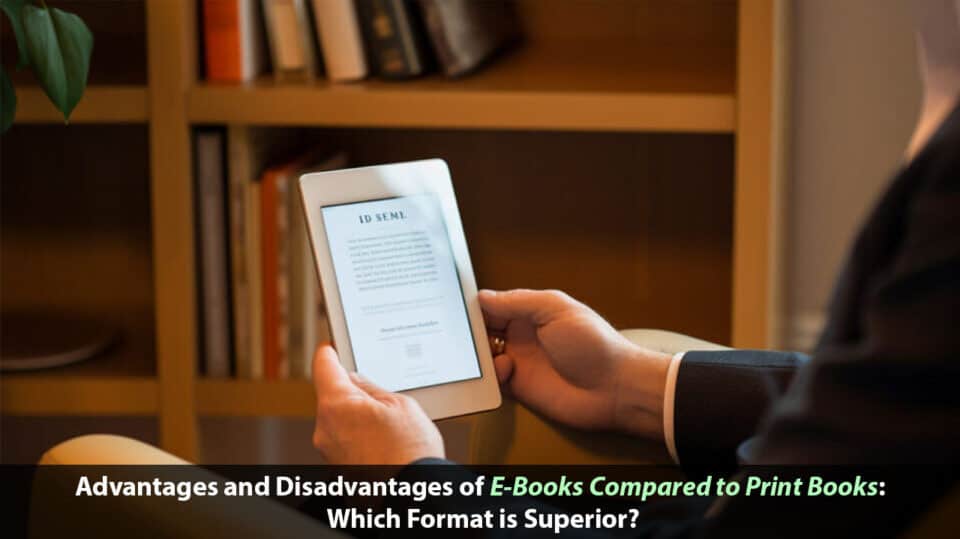Are you torn between the allure of traditional print books and the convenience of electronic books? Trust me, I’ve been there too. After delving deep into research, here’s a fact: E-books are portable and lightweight, enabling users to cart around an entire library on one device.
This post will enlighten you on the benefits and drawbacks of both formats, providing insight that would make your decision easier. Ready for a tour into the world of traditional vs digital reading? Let’s turn the page!
Key Takeaways
E-books offer the convenience of carrying an entire library on a single device, making them easily accessible wherever you go.
E-books are environmentally friendly, reducing carbon emissions and eliminating paper production and transportation.
E-books tend to be more affordable in the long run, with lower costs than traditional printed books.
Table of Contents
Understanding e-Books
E-books offer the convenience of storing multiple books on one device, making them easily accessible wherever you go.
One Device, Many Books
Imagine having an expansive library that fits in your handbag. Yes, this is the magic of E-books. This digital platform allows me to carry thousands of books on a single device, be it my smartphone, tablet, or E-reader such as Kindle.
No more lugging around heavy hardcovers or worrying about running out of reading material when I’m on the go! With one simple gadget, I can explore different genres, authors, and subjects anytime I want without hunting bookstores or waiting for deliveries.
It’s like owning a personal biblioteca wherever you go – one device holding many riveting pages just a tap away!
Accessible Everywhere
You’ll never find me without my E-book tucked away in my bag. Being stuck on a long commute or enduring an unexpected delay becomes less of a bother. All I need is my device, and I can access the world of literature anywhere, anytime.
Whether it’s in line at the coffee shop, waiting for the kids to wrap up soccer practice, or even during a surprising pause in my work day – every moment can turn into an engaging reading opportunity.
I also appreciate how E-books cater to my lifestyle as well as others with different needs. It doesn’t matter if you’re always traveling, have a hectic schedule, or have challenges like learning disabilities or visual impairment – E-books are accessible everywhere! Make use of their read-aloud feature; no need to halt your multitasking activities just because you want to follow along with your favorite novel.
This proves particularly handy when driving long distances or when cooking dinner, transforming idle moments into productive time spent immersing myself in riveting tales and insightful knowledge!
Environmentally Friendly

Switching to E-books significantly lowers our carbon footprint, which is a major step toward environmental conservation. Unlike traditional books, which require cutting down trees for paper production and energy-intensive printing processes, the digital format of E-books circumvents these environmentally damaging steps.
There’s no need for transportation or physical storage space either, as your entire library can be stored on one device and accessed from anywhere at any time. This crucial shift to digital reading creates an environment-friendly alternative that helps reduce deforestation and decrease carbon emissions – all while keeping the joy of reading alive!
Affordable in the Long Run
In the long run, choosing E-books over traditional books can be a more affordable option. While the initial cost of purchasing an e-reader may be higher, E-books tend to be cheaper than print books.
They eliminate the need for pre-production processes like printing, packaging, and shipping, which contribute to the overall cost of printed books. With E-books, you also have access to a wide range of free or low-cost digital content available online.
Additionally, E-books allow for easy sharing of content with multiple users without any additional costs involved. So if you’re looking for a budget-friendly reading experience that won’t break the bank in the long term, consider going digital with your book collection.
Understanding Printed Books
Printed books have long been a beloved and traditional way of reading. However, they come with certain drawbacks, such as limited storage space, high production costs, and their impact on the environment.
To learn more about why these factors should be considered when weighing the pros and cons of printed books versus E-books, continue reading below.
Retention of Information/Learning
I find that when it comes to retaining information and learning, physical books have an advantage over E-books. Studies have shown that reading comprehension tends to be better with print books compared to digital versions.
Maybe it’s the tactile experience of turning the pages or having a physical book in your hands that helps you remember what you read. Additionally, physical books allow for easy highlighting, note-taking, and bookmarking, which can enhance the learning experience.
While E-books do offer a read-aloud feature that makes them accessible for busy individuals or those with learning disabilities or visual impairments, there is still something special about holding a printed book and immersing yourself in its pages.
Impact on the Environment
Electronic books, or E-books, have a significantly lower impact on the environment compared to traditional printed books. Printed books contribute to deforestation as they require paper production, leading to air and water pollution.
Additionally, the transportation of physical copies results in carbon emissions. On the other hand, E-books have a lower environmental impact because they eliminate the need for paper production and transportation.
By reducing the demand for physical copies, E-books help conserve natural resources and reduce waste generation. Moreover, e-books offer instant accessibility without the need for shipping and delivery time.
Cost
Printed books often come with a higher price tag compared to electronic books. This is because printed books require various pre-production processes, such as printing, packaging, and shipping, which can be costly.
These costs are then passed on to consumers in the form of higher prices. On the other hand, electronic books eliminate the need for printing and shipping costs, making them more affordable.
In fact, many electronic books can be downloaded for free or at a significantly lower cost than their printed counterparts. So if you’re looking to save some money while still enjoying great reads, consider giving electronic books a try!
Electronic Books vs. Traditional Books: A Comparison

When comparing E-books and traditional books, there are several factors to consider, such as ease of use, eye strain, availability, shareability, price, and storage.
Ease of Use
Using E-books is incredibly easy and convenient. With just one device, you can have access to thousands of books right at your fingertips. No more need to carry around heavy bags or worry about running out of reading material while traveling.
E-books are also accessible everywhere, thanks to the ease of downloading and storing them on various devices. Whether you’re on a plane, waiting in line, or sitting in a cozy cafe, you can instantly dive into your favorite book with just a few taps.
One great advantage of E-books is their ability to be easily updated. Authors and publishers can quickly provide new editions or add additional content without the need for reprinting.
This means that you’ll always have access to the latest information and insights from your favorite authors.
E-readers also offer features that make reading easier on the eyes. Adjustable screen brightness and font size options allow for personalized comfort, reducing eye strain even during long reading sessions.
Additionally, E-books have a read-aloud feature which allows busy individuals or those with learning disabilities or visual impairments to still enjoy books by listening instead.
Eye strain

E-books can cause eye strain, which is not an issue with printed books. This is because reading on a screen for extended periods of time can lead to discomfort and fatigue in the eyes.
However, many E-readers now offer features that make reading easier on the eyes, such as adjustable screen brightness and font size. These options allow you to customize your reading experience and reduce the strain on your eyes.
Studies have also suggested that reading comprehension may be better when using physical books compared to E-books. So if you find yourself experiencing eye strain or wanting a “low tech” reading experience without distractions, opting for a printed book might be the better choice for you.
Availability
I love how easily accessible E-books are. With just a few clicks, I can download and start reading a book on my device anytime and anywhere. There’s no need to wait for shipping or worry about bookstore hours.
Whether I’m at home, on the train, or even on vacation, my favorite books are always available at my fingertips. Plus, with the advancement of digital publishing, authors and publishers can quickly update their E-book contents with the latest information without having to go through the lengthy process of reprinting.
This means I always have access to the most up-to-date versions of my favorite books.
Shareability
Sharing e-books is a breeze with just a few clicks. You can easily share your favorite books with friends and family, allowing for the easy dissemination of information and encouraging collaboration.
No need to worry about physical transfers or shipping – sharing e-books can be done instantly through email or file-sharing platforms. This convenience enables readers to connect, discuss, and explore new perspectives together.
So go ahead and spread the joy of reading by sharing your favorite e-books with others!
Price
I find that one of the most compelling advantages of E-books over printed books is their price. They are generally more affordable than traditional books due to the elimination of printing and shipping costs.
In fact, according to recent data from Amazon, the average price gap between E-books and hardcovers has increased by 75% in favor of E-books. For example, while a new hardcover bestseller may cost around $19.80, its E-book counterpart often sells for around $12, resulting in savings of about $7 per title.
This makes E-books an economical choice for avid readers who want to save money without sacrificing their love for reading.
Moreover, it’s worth noting that despite this affordability factor with E-books, there is still a strong preference for print books in the U.S., with 788.7 million units sold in 2022 alone.
However, considering both the cost savings and convenience aspects associated with E-books, it might be time to reconsider our book-buying habits and explore digital alternatives that offer not only financial benefits but also accessibility on various devices whenever and wherever we want to read.
Storage

With electronic books, you don’t have to worry about finding space for your growing book collection. E-books are stored digitally on a single device, which means you can have thousands of books at your fingertips without taking up any physical storage space.
No need for bulky bookshelves or boxes filled with books cluttering up your home. Instead, all your favorite titles can be neatly organized and easily accessed on your E-reader or tablet.
Plus, since E-books are lightweight and portable, you can take them with you wherever you go without the hassle of carrying around heavy paperbacks or hardcovers. So say goodbye to the storage woes and hello to the convenience of digital reading!
The Future of e-Books and Traditional Books
The future of E-books and traditional books is a topic that sparks much debate. As technology continues to advance, it’s clear that E-books are gaining popularity among readers. With the convenience of having an entire library at their fingertips on one device, many people find E-books to be a convenient and accessible option.
Additionally, with the rise of augmented reality experiences and interactive elements in digital reading, E-books offer a more immersive and engaging experience for readers.
However, there will always be a place for traditional books in our society. Printed books have a certain charm and nostalgia that cannot be replicated by digital media. The feel of turning pages, the smell of ink on paper, and the decorative value of physical books hold an appeal for many readers.
Moreover, some argue that printed books provide better retention of information and learning compared to digital editions.
It’s important to note that both E-books and traditional books can coexist in the future. While E-book sales continue to grow steadily, print book sales still dominate the market in certain demographics like young adults who prefer tangible copies.
Ultimately, whether you choose an E-book or a printed book depends on personal preference – each format has its own unique advantages and characteristics that cater to different types of readers.
Frequently Asked Questions About the Pros and Cons of These Two Options
What are the pros of electronic books compared to traditional books?
Some pros of electronic books include their convenience and portability, as multiple books can be stored on a single device. They also often offer adjustable font sizes, search functions, and the ability to highlight or bookmark passages.
What are the cons of electronic books compared to traditional books?
Cons of electronic books include potential eye strain from screen reading, reliance on battery power or internet connection, and the lack of physicality that some readers prefer when it comes to flipping through pages and physically owning a book.
What are the pros of traditional books compared to electronic books?
Traditional books offer a tactile reading experience that many individuals enjoy. They allow for easy note-taking in margins, no concern about battery life or technology issues, and they can create a sense of nostalgia with their physical presence.
What are the cons of traditional books compared to electronic ones?
Some cons of traditional books include their bulkiness and weight when carrying multiple titles, limited adjustable font sizes (which may pose challenges for those with visual impairments), higher costs for certain editions/types, and potentially limited availability if out-of-print or hard-to-find titles are sought after.
Conclusion
In conclusion, the choice between electronic books and traditional books ultimately depends on personal preferences and needs. While E-books offer convenience, accessibility, and environmental benefits, printed books provide a tangible reading experience and aesthetic value.
Both options have their pros and cons, but with advancing technology and changing reading habits, it’s clear that digital publishing is here to stay alongside its traditional counterpart.
Ultimately, the best option is the one that brings joy and fulfillment to readers.


